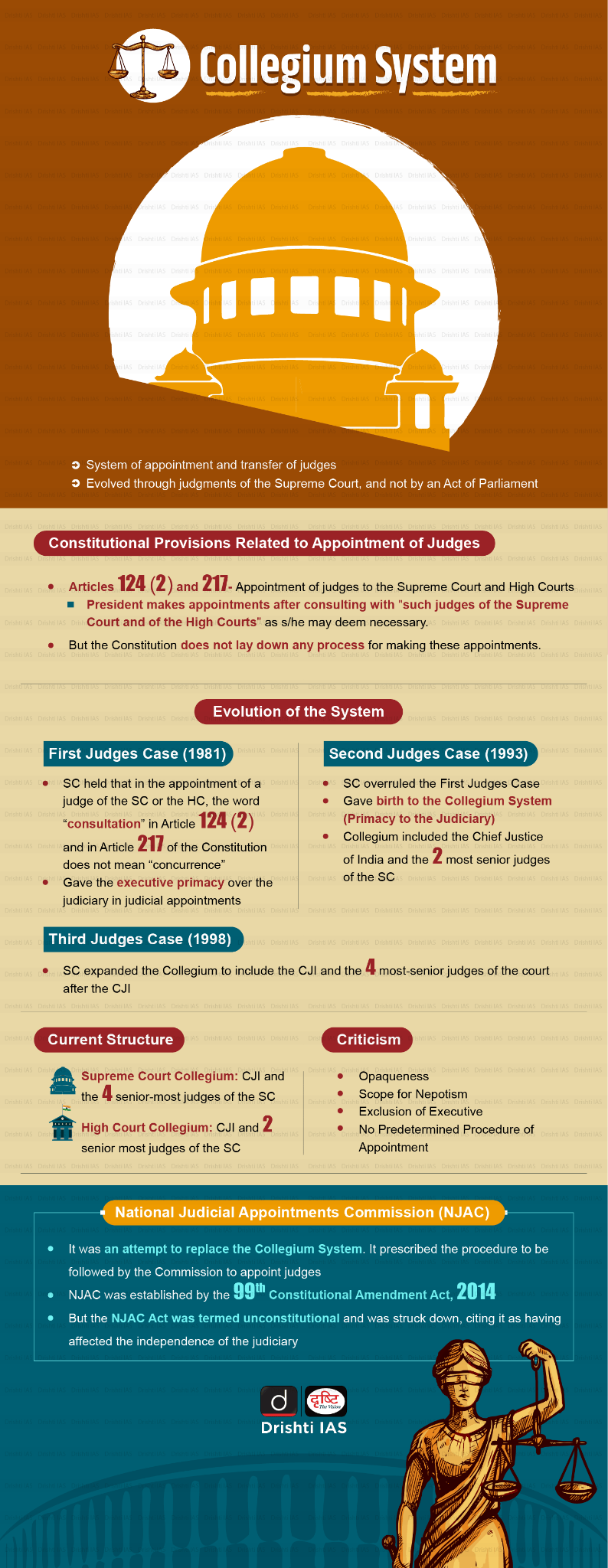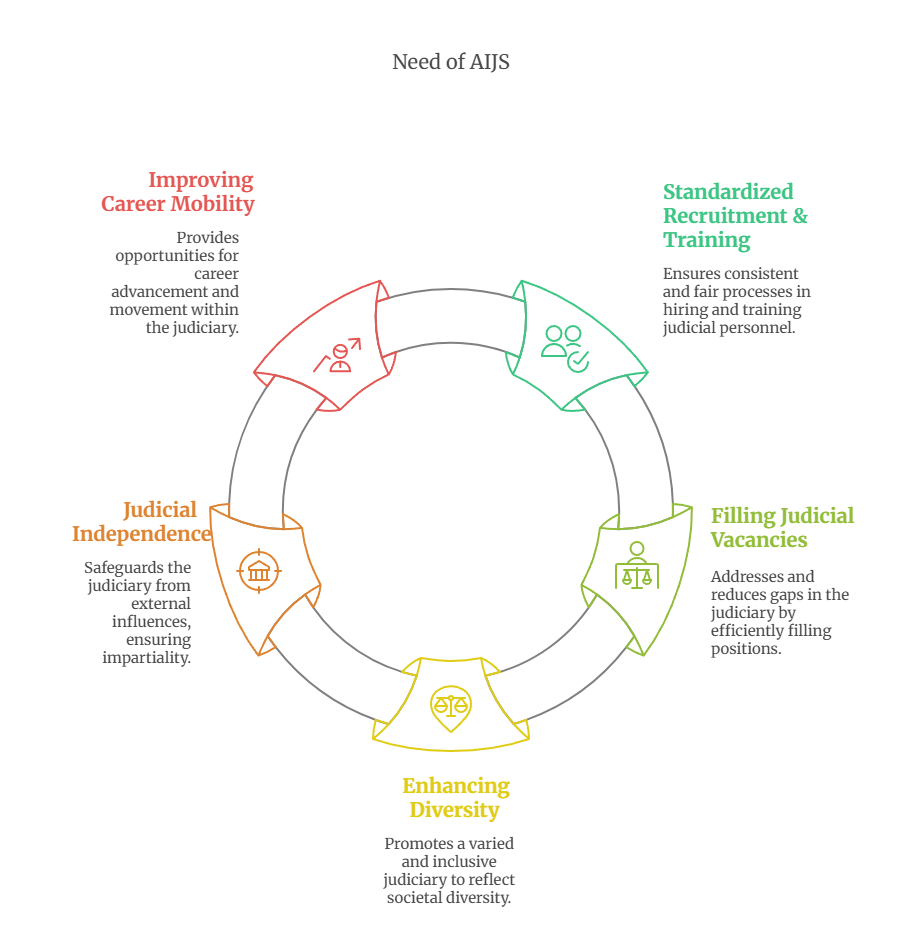Indian Polity
Need of Reforms in Judicial Appointments
- 28 Mar 2025
- 12 min read
For Prelims: National Judicial Appointments Commission (NJAC), All India Judicial Service (AIJS), 99th Constitutional Amendment Act, 2014, NJAC Act, 2014, Basic Structure, District Judges, Parliamentary Standing Committee, Supreme Court, High Court.
For Mains: Collegium system and issues related to it, Need of NJAC and AIJS.
Why in News?
The discovery of cash at Delhi High Court Judge's residence has reignited the debate on judicial appointments and raised questions about the collegium system.
- It has renewed focus on the National Judicial Appointments Commission (NJAC) and All India Judicial Service (AIJS).
How are Judicial Appointments Made in India?
- Appointment of Supreme Court Judges: A Supreme Court (SC) judge is appointed by the President under Article 124 (2) of the Constitution.
- The President appoints the Chief Justice of India after consulting necessary Supreme Court and High Court judges, while other judges are appointed in consultation with the Chief Justice and relevant judges.
- Appointment of High Court Judges: A High Court (HC) judge is appointed by the President under Article 217 of the Constitution.
- The chief justice is appointed by the President after consultation with the chief justice of India and the governor of the state concerned.
- For appointment of other judges, the chief justice of the concerned high court is also consulted.
- In case of a common high court for two or more states, the governors of all the states concerned are consulted by the president.
- Collegium System: It is the system of appointment and transfer of judges (SC and HC) that has evolved through judgments of the SC, and not by an Act of Parliament or by a provision of the Constitution.
What are the Challenges Associated with the Current System of Judges' Appointment?
- No Executive Involvement: Judicial appointments are made solely by judges, with no role for the executive and no oversight, risking secrecy and missed deserving candidates.
- Lack of Merit-Based Selection: No defined criteria for evaluating candidates for the post of judges create room for favoritism and nepotism and leads to Uncle Judge Syndrome.
- Uncle Judge Syndrome refers to nepotism in judicial appointments, highlighting favoritism and lack of transparency which undermines public confidence in the judiciary.
- Weakens Check and Balance: The collegium system centralizes power in the judiciary, disrupting checks and balances and increasing the risk of misuse and lack of oversight.
- Opaque Decision-Making: The collegium system operates without an official secretariat, making it a closed-door process.
- Decisions are made without public scrutiny, and no official records or minutes are publicly accessible.
- Lack of Diversity in Appointments: The higher judiciary lacks adequate representation, particularly of women and marginalized communities.
- Currently, the SC has two women judges, and as of August 2024, women comprise only 14% of High Court judges.
- Delay in Appointments: The collegium system has no fixed timeline, leading to delays through clarifications or reconsideration requests by the President.
- Since 2015, judicial appointments have been delayed, averaging 285 days, up from 274 days earlier.
What is the National Judicial Appointments Commission?
- About: NJAC was a proposed constitutional body to replace the collegium system for appointing judges to the SC and HCs.
- The 99th Constitutional Amendment Act, 2014, and the NJAC Act, 2014, were passed to establish a new system for judicial appointments.
- Composition: The NJAC would consist of:
- Chief Justice of India (CJI) as ex-officio chairperson.
- Two senior-most Supreme Court judges as ex-officio members.
- Union Law Minister as ex-officio member.
- Two eminent persons from civil society, selected by a committee of the CJI, PM, and Leader of Opposition (with one from SC/ST/OBC/minorities/women).
- Key Features:
- Veto Power: Any two members could block a recommendation if they disagreed.
- Appointment Criteria: Included seniority, regional representation, etc.
- Supreme Court’s Ruling in 2015: A 5-judge bench struck down the NJAC by a 4:1 majority, declaring it unconstitutional.
- Majority Opinion: The NJAC violated the basic structure of the Constitution by undermining judicial independence.
- Primacy of judiciary in appointments is part of the basic structure, and the NJAC diluted this by giving the executive (Law Minister) and non-judicial members a veto power.
- The risk of executive interference in judicial appointments was a major concern.
- Dissent (Justice Chelameswar): Supported the NJAC, arguing that the collegium system lacked transparency.
- Majority Opinion: The NJAC violated the basic structure of the Constitution by undermining judicial independence.
Why is NJAC Considered Better than the Collegium System?
- Transparent & Accountable: The NJAC was a structured and documented commission with defined procedures and recorded deliberations.
- Balanced Executive-Judiciary Role: The NJAC included the Law Minister and two eminent members, ensuring executive input without dominance.
- It also had a veto power, allowing any two members to block a candidate, preventing unilateral decisions.
- Better Representation: The NJAC ensured quicker appointments and mandated diversity with one eminent member from SC/ST/OBC, minorities, or women.
- Democratic Legitimacy: The NJAC was passed almost unanimously in the Parliament and was ratified by 16 states.
- International Comparisons: NJAC aimed to align India with global best practices by involving executive and legislative oversight in judicial appointments, as seen in many democracies like the US and UK.
- E.g., In the US, the Senate proposes names and its Judicial Committee conducts confirmation hearings.
What is the All India Judicial Service?
- About: AIJS is a proposed centralized recruitment system for additional district judges and district judges across all states.
- It aims to standardize judicial recruitment, improve efficiency, and ensure uniform quality in lower judiciary.
- Background: The idea was first proposed in Law Commission reports (1958, 1978) and was revisited in 2006 by a Parliamentary Standing Committee.
- Constitutional Basis:
- Article 312 allows for the creation of AIJS, similar to central civil services, through a Rajya Sabha resolution supported by two-thirds majority.
- Article 312(3) restricts AIJS to district judge-level posts and above, as defined in Article 236.
- Article 236 includes various judicial positions like city civil court judges, additional district judges, and sessions judges.
- Article 312 allows for the creation of AIJS, similar to central civil services, through a Rajya Sabha resolution supported by two-thirds majority.
- Need:
- Current Appointment: District judges are currently appointed under Articles 233 and 234 that give states the power to appoint district judges through State Public Service Commissions and High Courts, which oversee the subordinate judiciary.
- Article 233: The Governor appoints, posts, and promotes district judges in consultation with the High Court.
- Article 234: Recruitment of judicial officers (excluding district judges).
Conclusion
The controversy over judicial appointments highlights the flaws in the collegium system, reinforcing calls for reforms like NJAC and AIJS. Ensuring transparency, merit-based selection, and executive-judicial balance is essential for public trust and judicial independence while safeguarding constitutional principles and maintaining checks and balances.
|
Drishti Mains Question: Critically analyze the collegium system of judicial appointments in India. Also, discuss whether the National Judicial Appointments Commission (NJAC) would have been a better alternative. |
UPSC Civil Services Examination, Previous Year Question (PYQ)
Prelims
Q. Consider the following statements: (2019)
- The 44th Amendment to the Constitution of India introduced an Article placing the election of the Prime Minister beyond judicial review.
- The Supreme Court of India struck down the 99th Amendment to the Constitution of India as being violative of the independence of judiciary.
Which of the statements given above is/are correct?
(a) 1 only
(b) 2 only
(c) Both 1 and 2
(d) Neither 1 nor 2
Ans: (b)
Q. What is the provision to safeguard the autonomy of the Supreme Court of India? (2012)
- While appointing the Supreme Court Judges, the President of India has to consult the Chief Justice of India.
- The Supreme Court Judges can be removed by the Chief Justice of India only.
- The salaries of the Judges are charged on the Consolidated Fund of India to which the legislature does not have to vote.
- All appointments of officers and staff of the Supreme Court of India are made by the Government only after consulting the Chief Justice of India.
Which of the statements given above is/are correct?
(a) 1 and 3 only
(b) 3 and 4 only
(c) 4 only
(d) 1, 2, 3 and 4
Ans: (a)
Mains
Q. Critically examine the Supreme Court’s judgement on the ‘National Judicial Appointments Commission Act, 2014’ with reference to the appointment of judges of higher judiciary in India. (2017)






